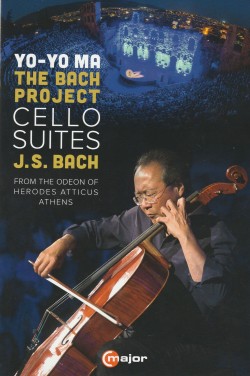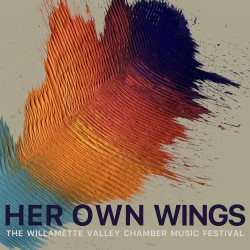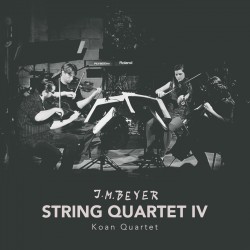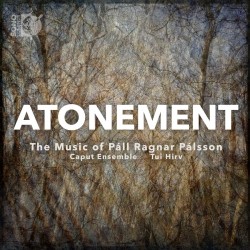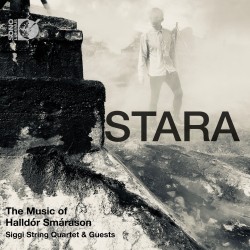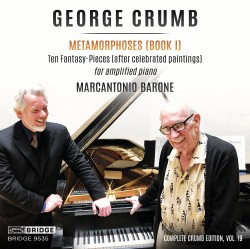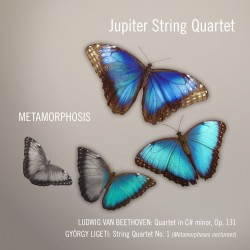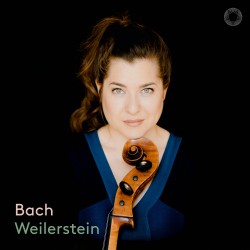Editor's Corner - October 2020
It’s been a couple of months since I last mentioned New Music Concerts, my day job until retiring last year, and I thought perhaps I had gotten it out of my system. I guess it’s not surprising that it is hard to put two decades of history behind me. While general manager at NMC I had the opportunity to work with the JACK Quartet on two occasions. The first was early in my tenure, and very early in their career, back in 2003 when I organized a masterclass with Helmut Lachenmann for the members of the quartet who were then studying at the Eastman School in Rochester. The quartet returned to Toronto in January 2016 for a concert co-presented by NMC and Music Toronto. In the pre-concert talk with Robert Aitken, they spoke about just how influential that afternoon spent with the German avant-garde composer a dozen years ago (and later attending NMC rehearsals for the Lachenmann portrait concert) was to their development as an ensemble, solidifying their commitment to contemporary music and their understanding of the importance of working directly with composers.
That program at the Jane Mallett Theatre included works by Xenakis, John Zorn, Rodericus (a 14th-century work adapted by violinist Christopher Otto) and John Luther Adams (b.1953). It is the latter which gives occasion to today’s reminiscence. On that concert they performed the American composer’s first string quartet The Wind in High Places, about which Adams says, “I imagined the quartet as a single sixteen-string Aeolian harp, with the music’s rising and falling lines and gusting arpeggios coming entirely from natural harmonics and open strings. Over the course of almost 20 minutes, the fingers of the musicians never touch the fingerboards of the instruments. If I could’ve found a way to make this music without them touching the instruments at all, I would have.”
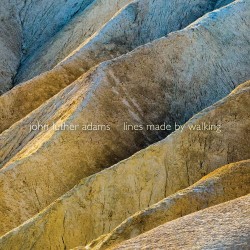 JACK’s latest CD Lines Made by Walking (Cold Blue Music CB0058 coldbluemusic.com/new-releases-2) features two subsequent quartets by John Luther Adams. His string quartet, untouched (2016), is a further exploration of the delicate and ethereal sound world of harmonic overtones, with the fingers of the musicians still not touching their fingerboards.
JACK’s latest CD Lines Made by Walking (Cold Blue Music CB0058 coldbluemusic.com/new-releases-2) features two subsequent quartets by John Luther Adams. His string quartet, untouched (2016), is a further exploration of the delicate and ethereal sound world of harmonic overtones, with the fingers of the musicians still not touching their fingerboards.
Compared with the two quartets described above, Lines Made by Walking (2019) is a veritable torrent of sound. But in reality, when taken on its own, it is a dreamy, contemplative work which proceeds at a gentle walking pace. Adams says “I’ve always been a walker. For much of my life I walked the mountains and tundra of Alaska. More recently it’s been the Mexican desert, mountain ridges of Chile, and the hills and canyons of Montana. Making my way across these landscapes at three miles an hour, I began to imagine music coming directly out of the contours of the land. I began work on my fifth string quartet […] by composing three expansive harmonic fields made up of tempo canons with five, six, and seven independent layers. (This is a technique I’ve used for years, in which a single melodic line is superimposed on itself at different speeds.) Once I’d composed these fields, I traced pathways across them. As I did this, each instrument of the quartet acquired a unique profile, transforming the strict imitative counterpoint of the tempo canons into intricately varied textures.” The work is in three movements and their titles – Up the Mountain; Along the Ridges; Down the Mountain – are aptly depicted by the music’s endlessly rising, and later falling, canons.
Although there have been personnel changes in the quartet since its first collaboration with Adams – only two original members remain – their understanding of and devotion to his music remains intact and undaunted. I can only imagine the patience it takes to master this gradually unfolding music in which seemingly nothing happens, but in which a marvellous stasis is achieved.
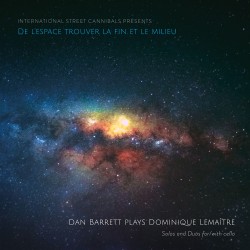 As Terry Robbins says a little further on in these pages, “It’s been a simply terrific month for cello discs.” There are three that I scooped up for myself, beginning with De l’espace trouver la fin et le milieu: Dan Barrett plays Dominique Lemaître – solos and duos for/with cello (New Focus Recordings fcr276 newfocusrecordings.com/catalogue). French composer Dominique Lemaître, born the same year as John Luther Adams (1953), studied humanities and musicology at the University of Rouen and later electroacoustics and composition at the Paris Conservatoire. Infused with the music of Bach, Debussy, Varèse, Ligeti and Scelsi, but also with extra-European influences, Lemaître ‘s works blend superimposed metres, polytextures, looped repetitions and an underlying modality. American cellist Dan Barrett, creator and director of the music ensemble International Street Cannibals (ISC), has been hailed as “a brilliant and driven cellist, composer, and conductor” (Huffington Post), whose instrumental playing is described as “fire and ice” (The New York Times).
As Terry Robbins says a little further on in these pages, “It’s been a simply terrific month for cello discs.” There are three that I scooped up for myself, beginning with De l’espace trouver la fin et le milieu: Dan Barrett plays Dominique Lemaître – solos and duos for/with cello (New Focus Recordings fcr276 newfocusrecordings.com/catalogue). French composer Dominique Lemaître, born the same year as John Luther Adams (1953), studied humanities and musicology at the University of Rouen and later electroacoustics and composition at the Paris Conservatoire. Infused with the music of Bach, Debussy, Varèse, Ligeti and Scelsi, but also with extra-European influences, Lemaître ‘s works blend superimposed metres, polytextures, looped repetitions and an underlying modality. American cellist Dan Barrett, creator and director of the music ensemble International Street Cannibals (ISC), has been hailed as “a brilliant and driven cellist, composer, and conductor” (Huffington Post), whose instrumental playing is described as “fire and ice” (The New York Times).
The disc begins with the cello duo Orange and Yellow II, performed with Stanislav Orlovsky. It pays homage to Morton Feldman and is a transcription of a piece originally written for two violas in 2009. The title makes reference to the eponymous painting created by Mark Rothko, to whom Feldman himself paid homage in Rothko Chapel, composed for the meditation room of the building of the same name. Although purely acoustic in nature, the layering and looping of the two instruments, and the reverberant space in which it was recorded, give the impression of electronic enhancement. Thot, referring to the Egyptian god Thoth, is an earlier work dating from 1994. It is a duet with clarinetist Michiyo Suzuki that begins from silence with a gradually building clarinet tone reminiscent of the Abîme des oiseaux movement in Messiaen’s famous Quatuor pour le fin du temps. The contemplative mood continues throughout the six-minute work, intermittently interrupted by bird-like chirps. The next piece, Mnaïdra for solo cello, opens abruptly and almost abrasively, although it, too, gradually subsides into warmer tones. Mnajdra is a Bronze Age temple situated to the south of the island of Malta, the isle of bees or the isle of honey, as it was called in ancient times.
Pianist Jed Distler joins the cellist in Stances, hommage à Henri Dutilleux, the famous French composer from whom Lemaître received both encouragement and compliments. It was written in 2015 and is dedicated to Barrett. The disc ends with another solo cello composition, Plus haut (Higher), which, although still in a quiet way, is the most virtuosic piece of the collection. Barrett shows himself astute across the spectrum from the softest nuance to the soaring heights.
Listen to 'De l’espace trouver la fin et le milieu' Now in the Listening Room
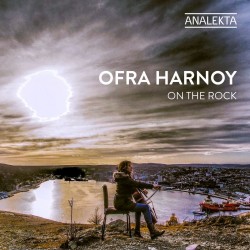 Renowned Canadian cellist Ofra Harnoy and husband/collaborator Mike Herriott have just released On the Rock, celebrating the music of Newfoundland (Analekta AN28909 analekta.com/en/albums). With 43 previous recordings, five JUNO awards and the Order of Canada to her name, Harnoy needs no introduction to the discerning readers of this magazine. The same can be said of multi-instrumentalist Herriott whose accomplishments in both the classical and jazz worlds run the gamut from lead trumpeter, jazz improviser, orchestral soloist, bassist, arranger and composer. In the summer of 2018 Harnoy and Herriott took a vacation in St. John’s, where Herriott had spent his formative years. Evidently she fell in love with the place and people of Newfoundland, one of the few locations in the world her career had not previously taken her, and they decided to buy a house and settle there. After their first collaboration for Analekta, Back to Bach, was released in 2019 they embarked on a journey to explore the island and research its music. The result is this charming disc, a mixture of traditional and popular songs in instrumental and vocal renditions, all arranged by Herriott, with the participation of singers Alan Doyle, Amanda Cash, Kelly-Ann Evans, Heather Bambrick and Fergus O’Byrne. O’Byrne also adds guitar and banjo to the instrumental contingent of guests Maureen Ennis (guitar), Bob Hallett (accordion, mandolin and Irish flute) and Kendel Carson (fiddle). All of the other instruments, and there are many, are played by Herriott except the solo and ensemble cellos of Harnoy.
Renowned Canadian cellist Ofra Harnoy and husband/collaborator Mike Herriott have just released On the Rock, celebrating the music of Newfoundland (Analekta AN28909 analekta.com/en/albums). With 43 previous recordings, five JUNO awards and the Order of Canada to her name, Harnoy needs no introduction to the discerning readers of this magazine. The same can be said of multi-instrumentalist Herriott whose accomplishments in both the classical and jazz worlds run the gamut from lead trumpeter, jazz improviser, orchestral soloist, bassist, arranger and composer. In the summer of 2018 Harnoy and Herriott took a vacation in St. John’s, where Herriott had spent his formative years. Evidently she fell in love with the place and people of Newfoundland, one of the few locations in the world her career had not previously taken her, and they decided to buy a house and settle there. After their first collaboration for Analekta, Back to Bach, was released in 2019 they embarked on a journey to explore the island and research its music. The result is this charming disc, a mixture of traditional and popular songs in instrumental and vocal renditions, all arranged by Herriott, with the participation of singers Alan Doyle, Amanda Cash, Kelly-Ann Evans, Heather Bambrick and Fergus O’Byrne. O’Byrne also adds guitar and banjo to the instrumental contingent of guests Maureen Ennis (guitar), Bob Hallett (accordion, mandolin and Irish flute) and Kendel Carson (fiddle). All of the other instruments, and there are many, are played by Herriott except the solo and ensemble cellos of Harnoy.
The album begins with a haunting rendition of the traditional She’s Like the Swallow performed by Harnoy and Herriott, who are then joined by Amanda Cash in Wayne Chaulk’s story/ballad Saltwater Joys. In a nod to Harnoy’s classical background, and perhaps to their previous disc, Herriott’s arrangement of Ron Hynes’ St. John’s Waltz begins with a solo cello line cleverly modelled on the Prelude from Bach’s Suite for Solo Cello No.1 in G Major which later develops into an ensemble of cellos accompanying Great Big Sea founder Doyle on vocals. There’s an instrumental interlude where Ennis joins Harnoy to perform Cara’s Waltz which she penned with Doyle. Although much of the album is mellow and balladic, especially in the tunes that feature Herriott’s flugelhorn stylings, things really get cooking in Harbour Buffett Double, a quartet with cello, fiddle, accordion and bass (with Herriott doubling on spoons) and the following Mussels in the Corner. This mainstay of local dance music sees Hallett playing all three of his instruments along with Harnoy and Herriott, all to the accompaniment of a rowdy pub crowd.
One interesting artistic choice is the mournful arrangement for 11 cellos of Stan Rogers’ rousing a cappella anthem Barrett’s Privateers, bringing an entirely new slant to the broken sailor’s lament. A further contribution to the sombre mood of the disc is Evans’ beautiful interpretation of Hynes’ Sonny’s Dream, another iconic tune by the unofficial poet laureate of Newfoundland. In his introductory notes Herriott suggests that this is just the beginning of their exploration of the music of his home province. As beautiful as this maiden voyage is, I hope that the next installment will include some of the roughhousing found in Newfoundland and Labrador’s traditional jigs and reels.
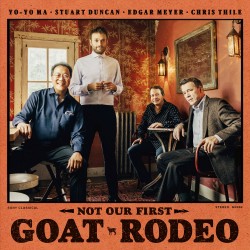 The final selection is not a cello disc per se, but having spent a large part of last month’s column on Yo-Yo Ma’s Bach Project I think I should mention at least in passing that his collective with Chris Thile (mandolin), Stuart Duncan (violin) and Edgar Meyer (bass) has released a second CD, Not Our First Goat Rodeo (Sony Music GR002 sonymusic.com/masterworks). The players are all top rank in their fields – bluegrass, country, jazz and of course, classical – and work wonderfully together. As with the 2011 album The Goat Rodeo Sessions – “Goat rodeo” is an aviation term for a situation in which 100 things need to go right to avoid disaster – we are presented with a wonderfully diverse album of original material which, while firmly rooted in American folk traditions, incorporates a wealth of influences. Once again the super stringband is joined by the lovely voice of Aoife O’Donovan for one tune, The Trappings, which you can check out here: youtube.com/watch?v=6yR-nFBnd9E.
The final selection is not a cello disc per se, but having spent a large part of last month’s column on Yo-Yo Ma’s Bach Project I think I should mention at least in passing that his collective with Chris Thile (mandolin), Stuart Duncan (violin) and Edgar Meyer (bass) has released a second CD, Not Our First Goat Rodeo (Sony Music GR002 sonymusic.com/masterworks). The players are all top rank in their fields – bluegrass, country, jazz and of course, classical – and work wonderfully together. As with the 2011 album The Goat Rodeo Sessions – “Goat rodeo” is an aviation term for a situation in which 100 things need to go right to avoid disaster – we are presented with a wonderfully diverse album of original material which, while firmly rooted in American folk traditions, incorporates a wealth of influences. Once again the super stringband is joined by the lovely voice of Aoife O’Donovan for one tune, The Trappings, which you can check out here: youtube.com/watch?v=6yR-nFBnd9E.
We invite submissions. CDs, DVDs and comments should be sent to: DISCoveries, WholeNote Media Inc., The Centre for Social Innovation, 503 – 720 Bathurst St. Toronto ON M5S 2R4.
David Olds, DISCoveries Editor
discoveries@thewholenote.com


